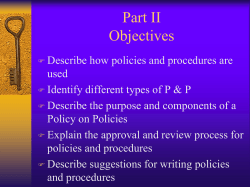
How to help your child revise ʹ Some ideas for...
How to help your child revise ʹ Some ideas for Parents Introduction dŚĞƌĞĂƌĞĂůŽƚŽĨŬƐŽŶ͞tŚĂƚƚŽƌĞǀŝƐĞ͟ďƵƚǀĞƌLJĨĞǁŽŶ͞,ŽǁƚŽƌĞǀŝƐĞ͘͟ůƚŚŽƵŐŚŵĂŶLJ teachers advise and help students to revise, many parents like to get involved. This guide is a summary of different ideas that work to help students learn. Learning is a very individual skill. Some people can read a text and remember; most need to reinforce through a variety of techniques. There is no doubt that revising and exams are stressful but this does not mean they have to be completely boring. Most children want support but they do not always know how to ask for it. By even taking an interest in their study you will be helping. Be prepared for mood swings and temper tantrums and try to remember it is the stress of the exams and not you that is causing it. If you work through this guide and tell your child that you can help them with this technique you will be helping them. Providing encouragement and guidance (and occasional nagging to get on) will all help. We hope this guide helps to provide some ideas for the future. Topic Planner The topic planner is a starting point for focusing revision. It is a way of helping to focus notes, tracking what needs to be done and showing when revision has taken place. Revision time-‐table Students should be working and working regularly. Occasionally dipping into their notes and last minute cramming are not effective ways to revise. The sooner the revision starts, the more reinforcement of learning there is. Students should be working for two hours every night. They need to have relaxation time and regular times to eat. If not, the brain will not concentrate and any revision could be futile as learning will not take place. Make a few copies of the time-‐table ĂŶĚƐƚŝĐŬŝƚƵƉŽŶƚŚĞĨƌŝĚŐĞŽƌĂďŽǀĞƚŚĞƚĞůĞǀŝƐŝŽŶ͘dŚĞƌĞ͛Ɛ not a teenager who does not visit these places regularly! Some Techniques to consider: Mind-‐mapping and diagrams These should be colourful diagrams that help to break larger chunks of information into smaller areas. They should use images to help link ideas. Flow diagrams help students to organise information into an order. Time-‐lines are particularly good for dating events in the correct order. Prompt Cards/ Revision Cards/ Colour Cards Again a way to break the notes into manageable chunks. Revision cards should contain: Keywords Important places or terms Core concepts Main points Possible questions Prompt cards have a key question/ topic or clue on one side and the answer on the other. The student can design these, give them to someone else and get them to test them. Colour coded cards can be used to order topics depending upon confidence. Just like traffic lights, green cards are used for information that they are confident with, orange if for unsure/ partial understanding and red is for needs attention. Recording notes onto tape In this case the notes that have been made are read onto a tape or another recording device and then they can listen to them. This coupled with doing another activity and not just sleeping can help. Pop tune notes Again for more musical and creative individuals the key ideas or themes can be put into rhymes, raps or pop tunes. Story telling Here the child tries to learn key ideas and themes through making up a story. This could be based upon a real story that they know well but if they are really creative they can make their own story up. Post it notes around the house Although you may have spent the past 16 years telling your child not to leave a mess, please forgive them with this one. Encourage them to stick post-‐it notes of key terms and vocabulary that can be splattered around the house-‐ especially the fridge. Acronyms / mnemonics A way of trying to remember lists. For example, Mary Vickers Eats My Jam Sandwiches Under EĞůƐŽŶ͛ƐWŝůůĂƌŝƐƚŚĞŵŶĞŵŽŶŝĐĨŽƌDĞƌĐƵƌLJ͕sĞŶƵƐ͕ĂƌƚŚ͕DĂƌƐ͕:ƵƉŝƚĞƌ͕^ĂƚƵƌŶ͕hƌĂŶƵƐ͕ Neptune, Pluto. Making Posters Make a poster of key facts/formulas and put it on your bedroom wall to help you revise as you get dressed. Everyone can remember what their room looks like and it is a good visual way of remembering small pieces of information. The internet dŚĞƐĐŚŽŽů͛ƐǁĞď-‐site (www.eirias.co.uk) has thousands of resources which can be used for revision and teachers are continually uploading resources for students (and parents) to access and to use for revision. We are making a real effort to try to organise these resources so they are easy ƚŽĨŝŶĚ͙ďĞĂǁĂƌĞƚŚĂƚƐŽŵĞƐƵďũĞĐƚƐŝƚĞƐĂƌĞŵŽƌĞĂĚǀĂŶĐĞĚŽŶƚŚŝƐƚŚĂŶŽƚŚĞƌƐ͘ There are also many websites that can be visited. These can be used effectively but try to monitor ƚŽĂǀŽŝĚƚŚĞƚĞŵƉƚĂƚŝŽŶŽĨŐĂŵĞƐĂŶĚƐŽĐŝĂůŶĞƚǁŽƌŬŝŶŐ;ƵŶůĞƐƐŝƚ͛ƐĂďŽƵƚ revision!) Not all revision should be done this way. Past questions These do need to be practised and the student should ensure that they have got these. But these should be used as part of the programme not the whole programme as the temptation may become to answer the questions with the notes always in front of them. Peer revising/ Family Revising This is where students work with one another. Encourage your child to: Give you a 15 minute lesson on a topic; Design a game of Taboo and then play it with them; Invite a friend around and design exam questions, team teach, share information, Revision should not be a lonely experience. Talking and social networking is an effective learning tool. General revision guides Try to get hold of one of these for each subject. Read through them and talk to your child about them. Make sure you know the exam board and specification that your child is doing. If in doubt or you have any questions or concerns then contact a teacher͙LJŽƵĐĂŶĚŽƚŚŝƐŝŶ person or via email-‐ ƚŚĞƌĞŝƐĂůŝŶŬŽŶƚŚĞƉĂƌĞŶƚƐ͛ƐŝƚĞƚŽ͞ŽŶƚĂĐƚĂdĞĂĐŚĞƌ͙͟..... they will attempt to respond within 1 working day.
© Copyright 2025





















